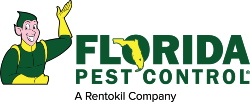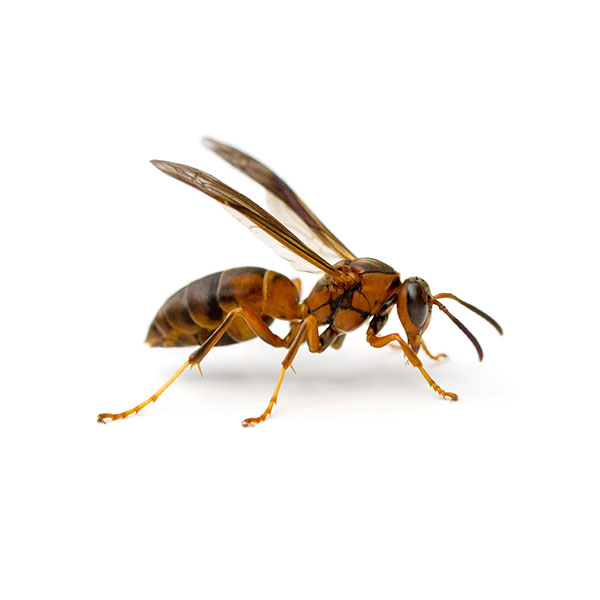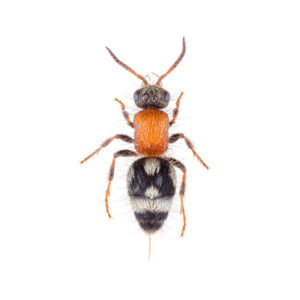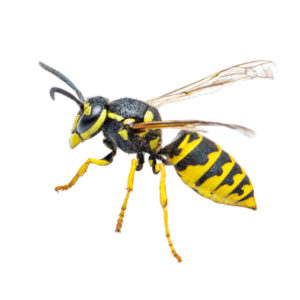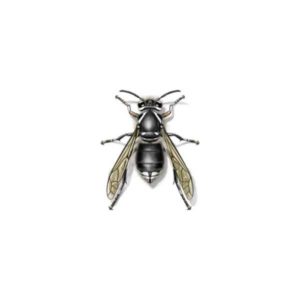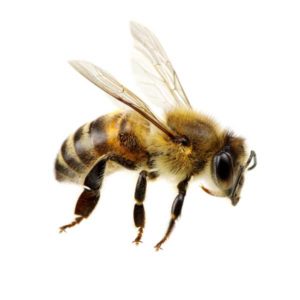Paper Wasps in Florida
Paper wasps are amongst the more common wasp species found in Florida. There are over 22 species of paper wasps in the U.S., and most of them are brownish in color with yellow markings.
Often confused with yellowjackets, paper wasps are sometimes referred to as umbrella wasps, and are most easily identified by their nests. Paper wasp nests often look like an upside-down paper cone and typically hang from a horizontal surface in a shaded, protected location. Like other types of wasps, paper wasps feed on insects, spiders, and the like.
What Do Paper Wasps Look Like?
Paper wasps are slender with long legs that dangle while flying. They typically grow up to 1 inch in length and have smooth bodies with yellow markings on their abdomen, which helps distinguish them from honey bees or European hornets.
Some species, like the European paper wasp (Polistes dominula), have a reddish tint, while others, like the northern paper wasp (Polistes fuscatus) have darker coloring. The common paper wasp (Polistes exclamans) can be identified by its reddish-brown body.
All types of paper wasps have noticeable antennae and a thin petiole, which is the narrow “waist” that connects their thorax to their abdomen. This gives them their unique, slender look.
Signs of a Paper Wasp Infestation
Knowing the signs of a paper wasp infestation can help you spot the problem early and prevent a more serious issue. Look out for:
- Nests near eaves or porch ceilings: Look for nests made of chewed paper fibers, often found in sheltered areas.
- Increased wasp activity: Wasps flying around nesting sites or entrances, especially during the warmer months as they build new nests.
- Nests that resemble open umbrellas: These nests are often made of thin layers of paper and can be seen hanging from tree branches or under roof overhangs.
- Presence of wasp larvae: If you see paper wasps bringing insects like caterpillars back to the nest, it’s a sign they’re feeding their larva.
- Aggressive behavior: If the nests are disturbed, paper wasps may become defensive.
If you notice these signs around your home, it’s a good idea to take action before the infestation grows. Our wasp experts at Florida Pest Control can safely remove nests and prevent future problems.
Habitat, Diet, Life Cycle & Behaviors
Understanding the habitat, diet, and behaviors of paper wasps can help homeowners manage their presence.
Where Do Paper Wasps Live?

Paper wasp nests are known to look like upside-down umbrellas and have a papier-mȃché feel to them. Unlike yellowjacket nests, paper wasp nests are partially open and not completely covered.
Nests can most often be found on tree branches or under eaves, attic rafters, and porch ceilings. Because nests can be built directly on a home, these wasps have been known to make their way indoors through holes in attic vent screens or underneath shingles.
Diet
Paper wasps mainly feed on nectar from flowers, but they also hunt other insects like caterpillars. They bring these insects back to their nests to feed their larva. This makes them helpful for controlling garden pests, though they can become a nuisance when they nest near human activity.
Life Cycle
The life cycle of a paper wasp starts in the spring. A fertilized queen finds a spot to build a new nest. She lays eggs that hatch into larvae, which grow and pupate before turning into adult wasps.These larvae develop into workers who help the queen by building the nest, gathering food, and caring for the next generation. In the fall, new queens are born. These queens overwinter and begin the cycle again the next year.
Behaviors
Similar to mud daubers, paper wasps are considered to be beneficial to the environment for keeping the insect population under control. They also assist in pollination by feeding on nectar. They are mostly solitary when it comes to feeding, but they live in colonies.
These wasps use pheromones to communicate with each other, especially when warning the colony of danger. They work together to build nests and care for the larvae. Worker wasps are responsible for gathering food, while the queen focuses on laying eggs.
Are Paper Wasps Dangerous?
Paper wasps are considered aggressive and have been known to sting repeatedly when threatened. For this reason, it’s important to never disturb their nest. Stings can be extremely painful, which is why you should leave it up to a professional wasp control company to control paper wasp infestations in or near your home.
Some people may have allergic reactions, which can lead to trouble breathing, dizziness, or swelling in other parts of the body. If this happens seek medical help immediately.
How To Get Rid of Paper Wasps
The best and safest way to get rid of paper wasps is by hiring a professional pest control service like Florida Pest Control. Professionals have the expertise to safely remove paper wasp nests and address potential nesting sites to prevent future infestations.
Attempting to remove a nest yourself can be dangerous and increase the risk of being stung. Don’t take the risk— let the experts handle it. If you’re dealing with a paper wasp problem, contact Florida Pest Control today.
Paper Wasp Prevention Tips
To avoid dealing with paper wasp infestations, follow these simple prevention tips:
- Seal cracks and holes: Close gaps around doors, windows, and eaves where wasps might build nests.
- Remove food sources: Clean up spills and garbage to prevent attracting wasps looking for food.
- Inspect outdoor spaces: Check porch ceilings, tree branches, and other sheltered areas for early signs of nests.
- Use wasp deterrents: Hang fake nests or apply deterrent sprays in high-risk areas.
- Trim vegetation: Cut back overgrown shrubs or trees to reduce potential nesting spots.
Need Help with Bees, Wasps, or Hornets?
If you’re dealing with bees, wasps, or hornets around your home, it’s important to act quickly. From paper wasps to velvet ant wasps, no matter the species, these stinging insects can be dangerous when threatened.
Florida Pest Control offers safe and effective solutions to remove these pests and prevent future issues.
Need help with Paper wasps?
We'll call you! Leave your information below.
FAQs
Are paper wasps aggressive?
Yes, paper wasps can be aggressive if they feel their nest or larvae are in danger. They use their stinger to defend themselves and their colony. If they feel threatened, they can sting multiple times to protect the nest, especially when guarding their queen.
How big will paper wasps make their nest?
Paper wasp nests can be about 6 to 12 inches wide. They are built in protected areas like eaves of houses, tree branches, or porch ceilings. A queen starts the nest, and it grows as more wasps join the colony and help build it.
Do paper wasps die in winter?
Paper wasp workers die in the winter, but the queen survives by overwintering in a safe spot. In the spring, she starts a new colony by laying eggs. The cycle repeats each year with a new queen and larvae.
Do paper wasps have a queen?
Yes, each paper wasp colony has one queen who lays all the eggs. The workers take care of the nest and protect the queen. In winter, the queen overwinters until she wakes up to start a new colony in the spring.
Do paper wasps pollinate?
Yes, paper wasps help pollinate plants. They feed on nectar from flowers and, while doing so, spread pollen.
